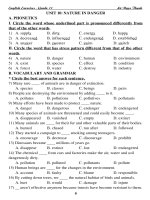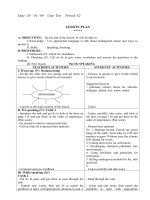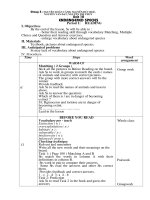Unit 10. Reading 11CB
Bạn đang xem bản rút gọn của tài liệu. Xem và tải ngay bản đầy đủ của tài liệu tại đây (84.1 KB, 2 trang )
Date: 08 / 01 / 09 Unit: Ten Period: 61
LESSON PLAN
*****
A. OBJECTIVES: By the end of the lesson, Ss will be able to:
I. Knowledge: - Develop such reading micro-skills as identifying main ideas and guessing in
context.
- Use the information they have read to discuss environmental destruction
and conservation.
II. Skills: - Reading, Listening, Speaking.
B. PROCEDURE:
I. Settlement (2'): - Who's absent today?
II. Checking (5'): - Call on 2 Ss to do exercises.
III. New lesson: Part A: READING
TEACHER'S ACTIVITIES STUDENTS' ACTIVITIES
I. Warm up: (5') Brainstorming
- Divide the class into small groups of 3-4. Then T
distributes the handout for Ss to match the causes with
effects and then brainstorm solutions to the problems.
- Call different groups to present their answers.
Cause Effect Solution
1. Cutting
down trees
a. Rare animals
disappearing
2. Producing
harmful gases
b. Reducing
water supply
3. Killing
animals
c. Destroying
the air
4. Using water
for industry
and agriculture
d. Changing
weather
- Introduce to the topic: Nature in Danger.
- Work in groups
- Present their answers:
Solution
Planting forests
Banning cutting trees
Banning releasing harmful chemicals
into the environment
Enlisting rare animals in the red books.
Banning killing animals for food or
industry.
Breeding and raising rare animals
Building dams for water storage.
Calling people to save water
- Listen and take notes
II. Pre-reading (7')
- Get Ss to look at the pictures on page 114 and name
the animals.
Vocabulary:
+ result in (v): cause
+ prohibit (v): ban, not allow
+ off-spring (n): children
+ coexist (v): live together
* Rub out remember
- Ask Ss to discuss and answer the questions on page
144:
1. The number of the animals is decreasing. They may
disappear from the earth if we do not take action to
protect them.
- Give feedback
- Work in pairs and name the animals
+ cheetah, pandas, and Siberian tigers
- Listen and take notes
+ do, bởi
+ cấm, không được phép
+ con, con cháu
+ cùng tồn tại chung sống
- Discuss and answer the questions:
2. People kill rare animals for food. They
destroy forests and pollute the air, soil and
water, so animals’ lives have been badly
affected.
III. While-reading (16')
Set the scene: You are going to read about how we
have destroy our environment and affected other
species and what we can do to save endangered
animals. Then you do the tasks in the textbook.
TASK 1:
- Listen
- Get Ss to read the passage silently and then do task
1. Then T may want to remind Ss of the strategies for
guessing the meaning of new words.
- Get Ss to do the task individually, then discuss the
answers in pairs
- Call on Ss to give their answers
- Check the answers with the whole class and give
feedback
TASK 2:
- Get Ss to read the passage again and do Task 2
individually.
- Call on some Ss to give their answers and ask them
to explain their choices and write their answers on the
board.
- Elicit feedback from the other Ss and give the correct
answers
- Give feedback and correct answers
TASK 3:
- Check if Ss can answer the comprehension questions
in task 3 without having to read the passage again. If
Ss can not, T gets them to read the questions carefully.
- Ask Ss to underline the key words to decide what
information they need to find in the text
- Instruct Ss to guess where in the passage they can
find the information,
- Get Ss to check their answers with a friend
- Call on some Ss to give their answers
- Give feedback and correct answers
- Read the passage silently and then do
Task 1 and give their meaning.
- Do the task individually, then discuss the
answers in pairs
- Give their answers:
1. extinct 2. protect 3. decrease
4.pollutants 5.endangered 6.interferences
- Listen
- Read through the passage again
individually
- Give their answers:
1. C (A & B are too narrow, D is not
supported by information in text)
2. B. (A is too broad. C & D are not
supported by information in text)
3. A (B is too narrow, C & D are not
supported by information in text)
4. C (A, B and D are not supported by
information in text)
- Check their answers with a friend
- Listen.
- Listen and answer
- Underline the key words to decide what
information they need to find in the text
- Listen and take notes
- Check their answers with a friend
- Give their answers
1. Four ways that people change the world
are:
+ They are changing the environmental by
building cities and villages
+ They are affecting the water supply by
using water for industry and agriculture.
- Listen
IV. Post-reading (5')
- Ask Ss to discuss to find out solutions to protect the
rare animals. (what do you think? I think...In my
opinion,..)
- Go around to check and offer help.
- Call on the groups to present their ideas
- Give feed back
- Listen and discuss in groups
- Present their ideas
- Listen and take notes
IV. Consolidation (3'): - Summarize the main point of the lesson
V. Homework (2'): - Ask Ss to learn by heart all of the new vocabularies and the main
ideas
- Ask Ss to prepare Part B - Speaking









